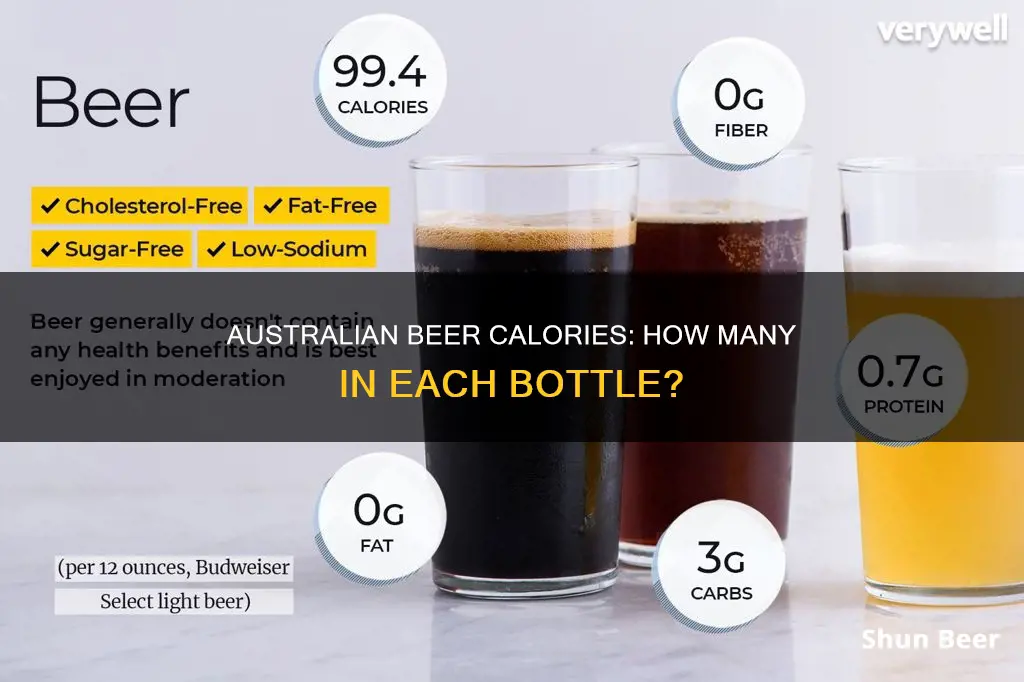
Beer is an integral part of Australian culture, with the nation consuming a staggering 1.7 billion litres per year. While it's a refreshing drink, it's important to be mindful of its calorie content. The average beer contains 100 to 200 calories per bottle, and with several popular Australian beers exceeding this range, it's easy to see how a few drinks can quickly add up. This is especially true for darker beers, which tend to be more calorie-dense. However, it's worth noting that the relationship between beer and weight gain is complex, and factors like metabolism and the nutrient content of the beer come into play.
Characteristics of Australian Beer
| Characteristics | Values |
|---|---|
| Average calories | 100 to 200 per bottle |
| Calories in a serving | 131 |
| Calories in a pint | 570 |
| Alcohol content | 3.0% to 6.5% |
| Carbohydrates | 0 to 15.0g |
| Sugar | 0 to 3.0g |
What You'll Learn

Calories in popular Australian beers
Australians are known for their love of beer, and while this love may be ingrained in our culture, it is important to remember that excessive beer consumption can lead to unwanted weight gain. A couple of beers can contain as many calories as a meal, and with Australia's consumption of 1.7 billion litres of beer per year, it is no surprise that the "beer gut" is a common concern among Aussie blokes.
The good news is that some beers are lower in calories than others, and with the growing popularity of non-alcoholic and low-carb options, there are now more ways to enjoy a beer without derailing your health goals.
Pure Blonde Premium Mid
- 19 calories/100ml or 67 calories per 355ml bottle.
- 3% alcohol and 0.3g carbohydrates per 100ml.
- A mid-strength beer with fewer calories due to lower alcohol content.
Hahn Super Dry 3.5
- 24 calories/100ml or 78 calories per 330ml bottle.
- 3.5% alcohol and 2.2g carbohydrates per bottle.
- Another mid-strength option with a refreshing taste.
James Boag's Premium Light
- 24 calories/100ml or 90 calories per 375ml can.
- 2.7% alcohol and 0.1g carbohydrates per 100ml.
- Lower alcohol content contributes to fewer calories.
Cascade Premium Light
- 25 calories/100ml or 94 calories per 375ml can.
- 2.6% alcohol and 9g carbohydrates per can.
- Light beer usually has fewer calories, but watch out for those that add more carbs to compensate for less alcohol flavour.
Carlton Dry Mid
- 26 calories/100ml or 98 calories per 375ml can.
- 3.5% alcohol and 1.4g carbohydrates per 100ml.
Pure Blonde Low Carb
- 26 calories/100ml or 98 calories per 375ml can.
- 4.2% alcohol and 0.5g carbohydrates per 100ml.
- Lower-carb beers often have fewer calories, and Pure Blonde is a full-strength option in this category.
Carlton Light
- 27 calories/100ml or 101 calories per 375ml can.
- 2.7% alcohol and 10g carbohydrates per can.
- Despite having lower alcohol content, it has slightly more calories than Carlton Dry Mid.
Great Northern Brewing Co Super Crisp Lager
- 27 calories/100ml or 98 calories per 375ml can.
- 3.5% alcohol and 1.4g carbohydrates per 100ml.
Powers Gold
- 27 calories/100ml or 101 calories per 375ml can.
- A light-tasting, cheap beer.
VB Gold
- 27 calories/100ml or 98 calories per 375ml can.
- 9.4g carbohydrates per can.
XXXX Summer Bright Lager
- 28 calories/100ml or 10.8g carbohydrates per 100ml or slightly over 3g per 375ml can.
- 4.2% alcohol.
Carlton Zero
- 28 calories/100ml or 26g carbohydrates per 375ml can.
- Alcohol-free but with a high carbohydrate content, making it one of the highest carb mass-market beers in Australia.
Carlton Cold Filtered
28 calories/100ml or 105 calories per 375ml can.
Foster's Light Ice
- 28 calories/100ml or 98 calories per 375ml can.
- Low-alcohol (2.3%) with 3.5g carbs per 100ml.
XXXX Gold
- 29 calories/100ml or 109 calories (454kJ) per 375ml can.
- The pride of Queensland, this beer has more calories than some others on this list.
Pacific Radler Lemon
- 29 calories/100ml or 109 calories (454kJ) per 375ml can.
- All the carbs in this beer come from sugar (13g per can).
Emu Draft
- 30 calories/100ml or 105 calories (425kJ) per 375ml can.
- 3% alcohol with 10.5g carbs, 0.4g of which is sugar.
Hahn Super Dry
- 30 calories/100ml or 90 calories per 330ml bottle.
- 4.6% alcohol and 0.7g carbs per 100ml.
Carlton Dry Fusion Lime
- 31 calories/100ml or 116 calories (488kJ) per 375ml can.
- Surprisingly, it has fewer calories than regular Carlton Dry, despite the added flavourings.
Great Northern Brewing Co Original
- 31 calories/100ml or 116 calories (488kJ) per 375ml can.
- 4.2% alcohol and 1.7g carbs per can.
Matilda Bay Lazy Yak
- 31 calories/100ml or 166 calories (488kJ) per 375ml can.
- 3.5% alcohol and 2.7g carbs per can.
Stella Artois Legere
- 31 calories/100ml or 100 calories (428kJ) per 330ml bottle.
- Lower alcohol (3.5%) version of the original Stella Artois.
Emu Bitter
- 33 calories/100ml or 137 calories (515kJ) per 375ml can.
- 4% alcohol and 8.1g carbs per can.
Emu Export
- 33 calories/100ml or 137 calories per 375ml can.
- 4.2% alcohol and 7.6g carbs per can. The same number of calories as Emu Bitter, but with a lower alcohol content.
Carlton Dry
- 33 calories/100ml or 139 calories (521kJ) per can.
- More alcohol than Carlton Mid but the same number of calories.
Carlton Mid
- 33 calories/100ml or 139 calories per 375ml can.
- 3.5% alcohol but a high 3.2g carbohydrates per 100ml.
Fosters Classic
- 33 calories/100ml or 139 calories (517kJ) per 375ml can.
- Overseas, it is promoted as Australia's favourite beer, but it has a surprisingly high number of calories.
Matilda Bay Frothy
- 34 calories/100ml or 143 calories (536kJ) per 375ml bottle.
- 4.2% alcohol, 9.4g carbs.
Swan Draught
- 35 calories/100ml or 146 calories (546kJ) per 375ml bottle.
- An ancient lager in Australian terms, packing 4.4% alcohol and 7.9g carbs.
Cascade Bitter
- 35 calories/100ml or 146 calories (546kJ) per 375ml can.
- A Tasmanian special with 4.4% alcohol and 9g carbs.
Matilda Bay Wild Yak
- 35 calories/100ml or 131 calories (551kJ) per 345ml bottle.
- An American-style pale ale with over 10g carbs per 100ml.
West End Draught
- 35 calories/100ml or 147 calories (552kJ) per 375ml can.
- 8.2g carbohydrates.
James Boag's Draught
- 36 calories/100ml or 130 calories (523kJ) per 375ml bottle.
- A Tasmanian beer that gained popularity during the "draught beer" craze of the 1990s.
Tooheys Extra Dry
36 calories/100ml or 125 calories (523kJ) per 345ml bottle.
Tooheys Old
- 36 calories/100ml or 136 calories (569kJ) per 375ml bottle.
- A dark ale first brewed by Tooheys in 1869, with 9.3g carbs.
Bulimba Gold Top Pale Ale
- 36 calories/100ml or 144 calories per 375ml can.
- Named for its gold-coloured bottle caps, introduced in 1898 to distinguish pasteurised beers from non-pasteurised ones.
Richmond Lager
- 36 calories/100ml.
- An American-style beer with 4.5% alcohol and 2.6g carbs.
James Squire 150 Lashes Pale Ale
- 37 calories/100ml or 140 calories per 345ml bottle.
- An easy-drinking, cloudy pale ale with 4.2% alcohol and 9g carbs.
Little Creatures Rogers
- 37 calories/100ml or 122 calories (509kJ) per 330ml bottle.
- A dense, red ale brewed in Fremantle with 11g carbohydrates per bottle.
Abbots Lager
- 37 calories/100ml or 140 calories per 375ml bottle.
- An ill-fated brew that is no longer available, with 10.5g carbs per bottle.
Carlton Draught
- 37 calories/100ml or 139 calories (581kJ) per 375ml can.
- A popular and tasty beer with 4.7% alcohol and 2.7g carbs per 100ml.
Miller Chill
- 37 calories/100ml or 111 calories (465kJ) per 330ml bottle.
- Don't be fooled by the "low carb" marketing—this beer has almost 4g of sugar and 9.9g carbs per bottle.
Matilda Bay Beez Neez
- 38 calories/100ml or 143 calories (589kJ) per 375ml bottle.
- A honey-flavoured pale ale with surprisingly little sugar (0.2g per 100ml) and 10.13g carbs.
Cascade Draught
- 38 calories/100ml or 143 calories (589kJ) per 375ml can.
- Another 4.7% alcohol beer with over 10g carbs per 100ml.
Tooheys New
- 38 calories/100ml or 143 calories (593kJ) per 375ml bottle.
- A delicious lager that has been on the market since 1931, with 9.2g carbs.
Ballarat Bitter
- 38 calories/100ml or 143 calories (593kJ) per 375ml can.
- A fine drop featuring Ballarat Bertie on the label, with 4.6% alcohol and 10.88g carbs.
Kent Old Brown
- 38 calories/100ml or 143 calories (593kJ) per 375ml can.
- The rich aroma promises more than its taste delivers, with 3.2g carbs and 4.4% alcohol.
Melbourne Bitter
- 38 calories/100ml or 143 calories (593kJ) per 375ml stubbie.
- A 4.6% bitter lager virtually unknown outside of Victoria, hopped with "Pride of Ringwood" hops and almost 11g carbs.
Little Creatures Pilsner
- 38 calories/100ml or 126 calories (528kJ) per 330ml bottle.
- A refreshingly bitter 4.6% alcohol pilsner.
Carlton Black Ale
- 38 calories/100ml or 143 calories (603kJ) per 375ml bottle.
- 12.4g carbohydrates.
Cascade Lager
- 38 calories/100ml or 143 calories (603kJ) per 375ml bottle or can.
- Known as "Blue" to the initiated, this simple 4.8% alcohol lager has 10.13g carbs.
Budweiser
- 39 calories/100ml or 129 calories (531kJ) per 330ml bottle.
- A weak-tasting 4.5% alcohol pale lager that is popular overseas.
Kosciuszko Pale Ale
- 39 calories/100ml or 162 calories (535kJ) per 330ml bottle.
- A cloudy, fruity ale with a decidedly Australian character, 9.1g carbs.
James Boag's Premium
- 39 calories/100ml or 146 calories (611kJ) per 375ml bottle.
- A full 5% alcohol Tassie stunner with subtle flavour and smooth finish, 8.7g carbs.
Kirin Megumi
- 39 calories/100ml or 130 calories (542kJ) per 330ml bottle.
- Another 5% alcohol beer, with 7.9g carbs. "Megumi" means "blessing" or "grace" in Japanese.
James Squire The Chancer Golden Ale
- 40 calories/100ml or 138 calories (576kJ) per 345ml bottle.
- Arguably the most golden-coloured beer in Australia, with 4.5% alcohol.
Stella Artois
- 40 calories/100ml or 168kJ per 100ml.
- The world's best-selling Belgian beer with 3.2g carbs.
Miller Genuine Draft
- 40 calories/100ml.
- This beer is not recommended due to its poor taste and similar nutritional profile to better-tasting beers.
Victoria Bitter (VB)
- 40 calories/100ml or 150 calories (634kJ) per 375ml stubbie.
- A 4.98% alcohol lager with surprisingly high 11.63g carbs.
Matilda Bay Fat Yak
- 40 calories/100ml or 150 calories (634kJ) per 345ml bottle.
- A low-sugar, high-carb, fruity pale ale with 12.75g carbs and 0.08g sugar.
White Rabbit White Ale
- 41 calories/100ml or 134 calories (562kJ) per 330ml bottle.
- A German-style wheat beer with 4.5% alcohol and 11.3g carbs.
Cascade Pale Ale
- 41 calories/100ml or 154 calories per 375ml bottle.
- An uncomplicated ale that lays claim to being the "Oldest Beer in Australia", with 5% alcohol and 11.25g carbs.
Crown Lager
- 41 calories/100ml or 154 calories (642kJ) per 375ml bottle.
- An insipid brew despite its fancy bottle and upper-class marketing, with 4.9% alcohol and 3.6g carbs
Calorie-Rich Tripel Beer: How Many Calories in One?
You may want to see also

Beer's impact on weight gain
Beers Impact on Weight Gain
Beer is an alcoholic drink made by fermenting grains with yeast. There are many different varieties that vary in strength, colour, and taste. The strength of a beer depends on the amount of alcohol it contains, which is measured as alcohol by volume (ABV). ABV refers to the amount of alcohol in a 3.4-oz (100-ml) drink, expressed as a percentage. The alcohol content of beer is usually 4–6%. However, it can range from very weak (0.5%) to exceptionally strong (40%).
Beer is high in carbohydrates and alcohol but low in almost all other nutrients. The calorie content of beer depends on its strength—the more alcohol it contains, the more calories it contains. Alcohol contains about seven calories per gram, which is higher than carbohydrates and protein (four calories per gram) but lower than fat (nine calories per gram).
How Beer May Cause Weight Gain
- It Increases Your Calorie Intake: Gram for gram, beer contains as many calories as a soft drink, so it has the potential to add a lot of calories to your diet. Some studies have also shown that drinking alcohol can increase your appetite in the short term, causing you to eat more than you otherwise would.
- Beer May Prevent Fat Burning: Drinking alcohol can prevent your body from burning fat. This is because your body prioritizes the breakdown of alcohol over other sources of fuel, including stored fat.
- It Contains Phytoestrogens: The flowers of the hop plant, which is used to flavour beer, are known to be very high in phytoestrogens. Phytoestrogens are plant compounds that can mimic the action of the female sex hormone oestrogen in your body. It has been suggested that the hops in beer might cause hormonal changes in men that increase the risk of storing belly fat.
How to Minimise Weight Gain
The best way to minimise weight gain from beer is to reduce your alcohol intake, exercise regularly, and improve your diet. If you're drinking heavily, you should also think about limiting your alcohol intake or giving it up completely. Try to avoid binge drinking, which is defined as having a lot of alcohol over one or two days.
Calorie Counting: White Beer's Surprising Number
You may want to see also

Low-calorie beers
Better Beer
Better Beer is a popular low-calorie option in Australia, with 87 calories, 4.2% alcohol content, and zero carbs or sugar. It offers a light and refreshing taste without compromising on flavour, making it a top choice for those seeking a healthier beer.
Burleigh Brewing Bighead
Burleigh Brewing Bighead is a Queensland beer that's made waves as the first no-carb beer in Australia. With 88 calories and 4.2% alcohol content, it's a delicious and flavourful option for those mindful of their calorie and carbohydrate intake.
Hahn Super Dry Premium Low Carb
Hahn Super Dry is a well-known low-carb beer with a refreshing taste. With 99 calories, 4.6% alcohol content, and just 0.7% carbs per 100ml, it's a crisp and balanced choice for those watching their calorie intake.
Great Northern Original
Great Northern Original is a smooth and easy-drinking beer with 102 calories and 4.2% alcohol content. It's a popular choice for Australians, especially for outdoor activities, thanks to its light flavour.
Coopers Mild Ale
Coopers Mild Ale is a family-owned Australian business that's been brewing beer for over 150 years. Their mild ale has 127 calories and 3.5% alcohol content, offering a balanced flavour profile for those who prefer a milder taste.
XXXX Gold Lager
XXXX Gold Lager is a Queensland favourite with 109 calories and 3.5% alcohol content. It's an easy-drinking, smooth, and light-flavoured beer, making it a refreshing choice for any occasion.
Stone & Wood Pacific Ale
Stone & Wood Pacific Ale is a popular Australian pale ale that uses local ingredients. With 132 calories and 4.4% alcohol content, it offers a unique blend of fruity and hoppy flavours, providing a refreshing drinking experience.
While these low-calorie beers offer a healthier alternative, it's important to remember that they should be consumed in moderation as part of a balanced lifestyle. Additionally, when comparing low-calorie beers, consider the variation in calorie and carbohydrate content to make an informed choice that aligns with your specific goals and preferences.
Calories in O'Doul's NA Beer: Nutritional Breakdown
You may want to see also

Beer and sugar content
Beer is a popular drink in Australia, with the nation consuming around 1.7 billion litres per year. It is made from carbohydrates like sugar or starch found in hops and malt, and contains at least seven calories per gram. The sugar extracted from barley and grains is what causes beer to ferment, and the more sugar present, the more alcohol there will be, resulting in more calories.
The calorie content of beer varies depending on the brand and type, but on average, a single beer can contain as many calories as a standard-sized Mars Bar (136 calories) and almost as many as a plain Krispy Kreme donut (190 calories). The higher the alcohol percentage, the more calories the beer will have. For example, a lager with 4.5% ABV and 12 oz will have around 135 calories, while 12 oz of a barrel-aged stout at 10.5% ABV will have about 315 calories.
Some beers are lower in calories than others, and non-alcoholic beers are also available. For instance, Better Beer, a new beer in Australia, has only 87 calories. Queensland's Burleigh Brewing Co.'s Bighead is another no-carb option with 88 calories. Hahn Super Dry, a popular low-carb option, has 92 calories, while Great Northern Original has 102 calories.
When it comes to sugar content, some beers have zero sugar, like Better Beer and Burleigh Brewing Bighead. Hahn Super Dry, a low-carb option, has 0.7g of carbohydrates per 100ml. Pure Blonde Low Carb has 0.5g of carbohydrates per 100ml, while Pacific Radler Lemon has 13 grams of sugar per 375ml can.
While beer is a beloved part of Australian culture, enjoyed during social gatherings and relaxation, it is important to remember that excessive consumption can contribute to weight gain. The high calorie and carbohydrate content of beer, along with its ability to stimulate appetite, can lead to unwanted weight gain if not consumed in moderation.
Calories in Summer Shandy Beer: How Much?
You may want to see also

Calculating calories in beer
Beer is a popular drink in Australia, with the nation consuming around 1.7 billion litres per year. It's important to be mindful of the calorie content of beer, especially if you're watching your weight. The good news is that calculating the calories in beer is fairly straightforward, and there are even online calculators that can do the work for you.
Factors Affecting Calorie Content
The calorie content of beer depends on various factors, including the type of beer, the amount of alcohol it contains, and the presence of carbohydrates and sugar. In general, the higher the alcohol content, the more calories the beer will have. However, it's important to note that the colour of the beer is not a reliable indicator of its calorie content. Darker beers don't necessarily have more calories than lighter ones.
Calories from Alcohol and Carbohydrates
In beer, the main sources of calories are alcohol and carbohydrates. During fermentation, yeast breaks down simple carbohydrates, but longer chains of carbs that the yeast can't break down remain in the beer and contribute to the overall calorie count. On average, about 60% of the calories in beer come from alcohol, while the remaining 40% come from residual carbohydrates.
Calculation Formulas
To calculate the calories in a beer, you need to know its original and final gravities. You can then use the following equations to determine the total number of calories from alcohol and residual carbohydrates:
- Calories from Alcohol = 1881.22 Final_Gravity (Original_Gravity – Final_Gravity) / (1.775 – Original_Gravity)
- Calories from Carbohydrates = 3550 Final_Gravity ((0.1808 Original_Gravity) + (0.8192 Final_Gravity) – 1.0004)
By adding these two values together, you can find the total calorie content of the beer.
Calories in Popular Australian Beers
The calorie content of beer varies widely depending on the brand and type. Here are the calorie counts for some popular Australian beers:
- Pure Blonde Premium Mid (355ml): 67 calories
- Hahn Super Dry 3.5 (330ml): 78 calories
- James Boag's Premium Light (375ml): 90 calories
- Cascade Premium Light (375ml): 94 calories
- Carlton Dry Mid (375ml): 98 calories
- Pure Blonde Low Carb (375ml): 98 calories
- Carlton Light (375ml): 101 calories
- VB Gold (375ml): 94 calories
- Carlton Zero (375ml): 26 grams of carbohydrates
- Carlton Draught (375ml): 139 calories
- Little Creatures Pale Ale (330ml): 156 calories
- Coopers Sparkling Ale (375ml): 207 calories
Perspective on Calorie Content
To put the calorie content of beer into perspective, a single beer can contain as many calories as a standard-sized Mars Bar (136 calories) or even a plain Krispy Kreme donut (190 calories). Consuming several beers can quickly add up to the same number of calories as a full meal. Therefore, it's important to be mindful of your beer consumption, especially if you're watching your weight.
Canadian Beer Calories: How Many in a Glass?
You may want to see also
Frequently asked questions
The number of calories in Australian beer varies depending on the brand, type, and volume. On average, a single beer can contain as many calories as a standard-sized Mars Bar (136 calories) and almost as many as a plain Krispy Kreme donut (190 calories).
The calorie content of beer is influenced by the alcohol content, with higher ABV beers tending to have more calories. Additionally, the amount of sugar and carbohydrates in the beer can also impact the calorie count.
Yes, some Australian beers are marketed as low-calorie options, such as Hahn Super Dry, Pure Blonde, and Better Beer. These beers typically have fewer than 100 calories per bottle or can.
The calorie content of Australian beers is similar to that of beers from other countries. For example, a standard lager with 4.5% ABV typically has around 135 calories, regardless of its origin.
You can use the following formula to calculate the approximate number of calories in a beer: ABV% x 2.5 x ounces of beer. For example, a 16-ounce beer with 6% ABV would have about 240 calories.







